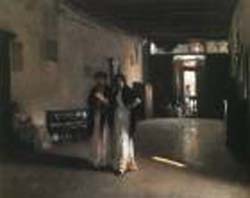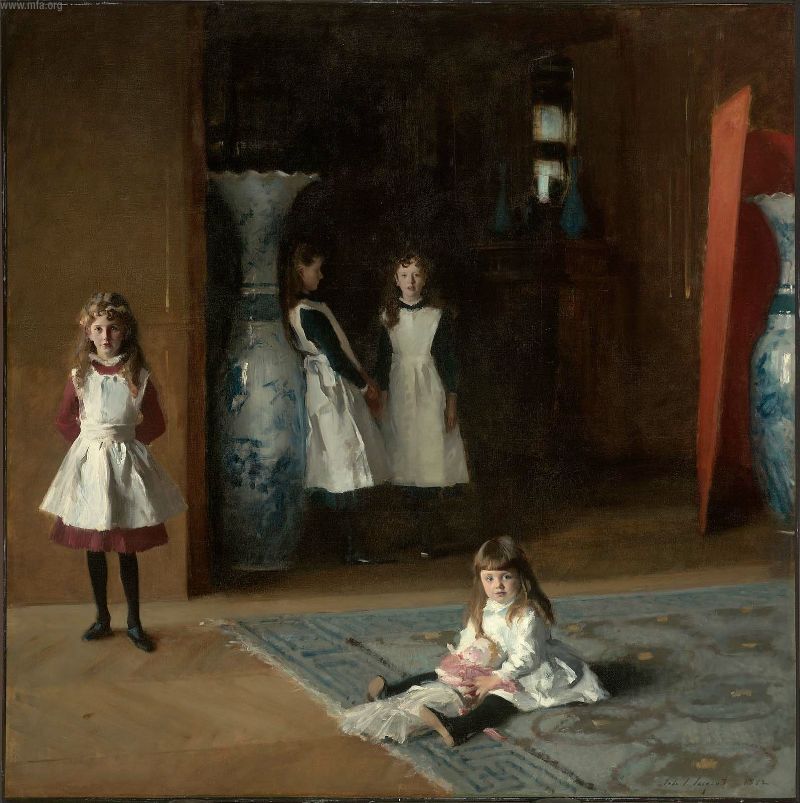Daughters
of Edward
Darley Boit
John Singer
Sargent -- American
painter
1882
Museum of Fine
Arts,
Boston
Oil on canvas
221.9 x 222.6
cm (87 3/8
x 87 5/8 in.)
Gift of Mary
Louisa Boit, Julia Overing Boit, Jane Hubbard Boit, and Florence D.
Boit in memory of their father, Edward Darley Boit 19.124
Jpg: mfa
/ Jim's
Fine Art Collection
(See interactive
zoom at the MFA)
In 1883 Sargent
exhibited at the
Salon his portrait which he called Portraits d'Enfants or
Daughters
of Edward Darley Boit. Its composition was criticized for its "four
corners
and a void" the children not having any relationship to each other but
the painting, overall, was widely praised. (Charteris, P57-58). The
painting
is large and exactly square, for this reason and it's composition, it
baffled
and intrigued the critics of the day.
When I first saw
this picture I found
it rather odd myself. I felt the girls are curiously isolated from each
other even before I read Charteris's account. The title of the painting
clearly indicates that these are daughters, but it was my first
inclination
that the front two girls must be the daughters -- but what am I to make
of the rear two girls? Why would he paint them in such a fashion? They
are both clearly dressed in very similar clothes, almost a uniform --
could
they be children of servants? The one in profile is almost
unintelligible
as if he was intentionally de-emphasizing the two from us. Why would he
do this? Were the daughters close to the servants? Were they playmates?
Why would they even be included in the picture?
As always (or
nearly so) my first
inclination was almost totally wrong. All four children, it turns out,
are the daughters of Edward Darley Boit. But instead of answering
questions,
for me, it only raised more -- why are the rear daughters so obviously
beyond the foreground of what one might expect of a portrait painting?
Do you feel a sense of melancholy here? I did.
****
Before I answer
these questions (and
I will later) allow me to turn your attention to the artist himself to
see if I can shed light into the mystery of why this composition.
Hon Evan Charteris'
writes in his
biography of Sargent:
I met Sargent
for the first
time in May, 1884, at a party given by Mrs. Henry White at Loseley. I
have
found a record of my first impression in a letter written at the time .
After giving a list of the party it runs: "Also Sargent, who is
interesting
round and about his own subject, though he talks slower and with more
difficulty
in finding words than anyone I ever met. When he can't finish a
sentence
he waves his fingers before his face as a sort of signal for the
conversation
to go on without him -- at least, that is the impression I came after
staying
in the house with him." That impression was modified as time went on,
though
he always talked slowly. He gave the idea of one grasping at words
which
danced elusively in his brain; his conversation was never fluent, but,
like his painting, it could be immensely descriptive. He wasted no
words
-- it may even be doubted if he had any to waste -- but those he used
were
like strokes of his brush, significant and suggestive; indeed he could
convey a weight of meaning by a gesture or a truncated phrase. He could
transpose sense and experiences into words with more character and tang
in his rendering than many more accomplished masters of phrase. When he
talked of matters related to art, or when he was with intimates, he
found
words with comparative ease. Even then there was hesitation, as though
he was at his easel determining the next stroke of his brush. But his
hesitation
was itself often expressive and in any case so characteristic that
certainly
no friend of his would have had it otherwise. So much lay in the back
of
it: such authority, such anxious sincerity, and at the same time, so
much
humor and finesse. No man had more entirely home-made opinions so
wholly
the unadulterated product of his own reflection or experience. His wit
was true and direct, free of paradox, an overflow of his own
personality.
He resembled Henry James, in that nothing would induce him to make a
speech.
More than once at a dinner in early days the shouts of the diners got
him
to his feet, when he would stand struggling with his nervousness,
apparently unable to utter. On one occasion blurting out, "It's a
damned
shame," he subsided into his seat amid a tempest of applause. (Charteris
, P145-146)
****
Edward Darley Boit
(1840-1915) was an
fellow expatriate American Painter and his wife Mary Louisa Boit were
friends
of Sargent. They lived for periods in Boston, in Rome, and in Paris.
Most
likely they met in Paris although it's not known exactly when. It was
in
Paris that he painted the picture. Like Sargent, they were prominent
members
of the American artistic community and therefore shared quite a bit of
camaraderie. It was the Boits, interesting enough, that Ralph
Curtis mentions in his letter
of John visiting the day of "disaster" of his Madame X
showing
-- 1884 Salon, two years after this.
The painting of the
children is in
the Boit's Paris apartment, 32, avenue de Friedland. You
can
see a number of influences that Sargent was working with at the time.
On
his trip to Spain in the late 1870's he studied Velazquez who had a
great
influence on many French painters. Sargent himself copied Velazquez's
Las Meninas of 1656 (Museo del Prado, Madrid) in 1879 and you can
see
the idea of depth, dark  tones
and shading with a source of light at the far distance, and the change
in focus from people at various distances. He also obviously drew
from his earlier work in the Venetian
studies of c. 1880-2, in which he had been "experimenting with the
effects of receding perspectives, shifting focus, oblique light and the
atmospheric qualities of dark spaces . . . ." (Ormond,
P.56) tones
and shading with a source of light at the far distance, and the change
in focus from people at various distances. He also obviously drew
from his earlier work in the Venetian
studies of c. 1880-2, in which he had been "experimenting with the
effects of receding perspectives, shifting focus, oblique light and the
atmospheric qualities of dark spaces . . . ." (Ormond,
P.56)
Although the
towering vases and the
large room seem to dwarf the children, but they did in fact exist "The
vases in the picture, made by the potter Hirabayashi or his workshop,
of
Arita, Japan share the family migratory existence, making sixteen
transatlantic
crossings and suffering repeated damage"
(Ormond,
P.56)
The four Daughters
of Edward Darley
Boit are, from left to right: Mary Louisa (1874-1945, about 8 years old
at the time), Flourennce (1868-1919, about 14 yrs old), Jane
(1870-1955,
about 12 yrs old), and Julia (1878-1969, about 4 yrs old). None of the
girls ever married, and both Flourennce and Jane, the two rear
daughters,
became to some extent mentally or emotionally disturbed. Mary Louisa
and
Julia, the front two girls, remained close as they grew older, and
Julia,
the youngest, became an accomplished painter in water-colors. (Ormond,
P.56)
There was no way
John Sargent could
have know the psychology or what life held for these children when he
painted
them in 1882. Could this have been a fluke-- the way they were
positioned,
the rear daughters detached from us, the one leaning on the vase not
even
looking at us? Maybe. Was he just lucky? Possibly. But it is my
considered
opinion that John Singer Sargent's gift of seeing the world was very
special.
I know, from books,
that he sometimes
chose the clothes for his sitters. I don't know to what degree he
allowed
them to find their own place -- there own buoyancy (there
is no known study of this painting). What I do know, in the paintings
in
which he took great care and did many studies, such as Madame X
and Carnation, Lily, Lily, Rose, he sketched his subjects in
many
different ways following them like a "snapshot photographer to catch
the
[person(s)] in attitudes helpful to his main purpose" (Sir
Edmund Grosse, Charteris , P145-146).
Vernon Lee writes:
I remember
once asking whether
he was aware of the character of the people he painted; and his denial
of all knowledge of interest in their psychology is surely confirmed by
the very fact that . . . this most reserved and delicately
unmercenary
of artists did make certain portraits of certain sitters, and pocket
the
price, evidently without a suspicion of what he had told about those
who
paid it. That quite unverbal, intuitive imagination of his had fastened
on a the facial forms, the pose and gesture, sometimes even the
accessories,
which revealed the man or woman's character and life. To this kind of
imagination
I would apply Ruskin's adjective penetrative, for Sargent's art
does penetrate to the innermost suggestion of everything he painted,
[and
he] does so by following its merely visible elements. (J.S.S.
In Memriam, By Vernon Lee,
P.253-254)
But unlike Romanticism
or Pre-Raphaelelite
Art Sargent was most Modern, in the truest sense of the word. He
wanted
to convey only what he saw and convey it in the way he saw it.
I do not
think Sargent,
despite the infinite ingenuity he showed in his attempts, was an
imaginative
painter like Watts or Besnard, imaginative in the sense of building up
allegories and narrating events. His symbolism was immanent in the
aspects
which he painted. (Vernon
Lee, P.254)
If
you look at
John Sargent's portraits, I think you can see over and over again, the
personality of the individuals coming through.
No one else could
have painted Daughters
of Edward Darley Boit. The genius of John Singer Sargent is not so
much in his conscious mind or what he does per say but in what
he doesn't
do. It is his unconscious brilliance and sensitivity to his great art
flowing
out from years of training -- a lifetime of painting (from when he was
a little boy) and his special way in which he was so verbally shy. It
is
as if he was a chameleon -- not in the sense of his own colors changing
(for he was so firmly grounded) but in the way, like many great artist
(certainly not all) his weakness (or what we might call weakness
-- his verbal shyness) was possibly a byproduct of, or a contributing
factor
towards his great gift -- that ability to feel an energy of a room, of
a person, of a space, to feel it and sense it to a degree and to a
level
above most of us. It is as if he could feel the subconscious energy of
others (most importantly not disturb it) and transpose it into paint,
onto
canvas -- possibly even beyond his own conscious understanding.
In the hands of a
lesser artist the
composition of Daughters of Edward Darley Boit would have been
ruined
-- it is just too oddly strange. Like the most delicate flower, this
painting's
petals would have wilted instantly in the crass temperament of
pre-conceived
notions. But not here, and not by John Singer Sargent, for this
painting
is truly Penetrative!
Notes
Provenance:
The artist; to
Edward Darley Boit, Paris, 1882; to his daughters, the sitters; to MFA,
1919, gift of Mary Louisa Boit, Florence D. Boit, Jane Hubbard Boit,
and Julia Overing Boit
Exhibitions
John Singer Sargent
Retrospective, 1989-1999
|












